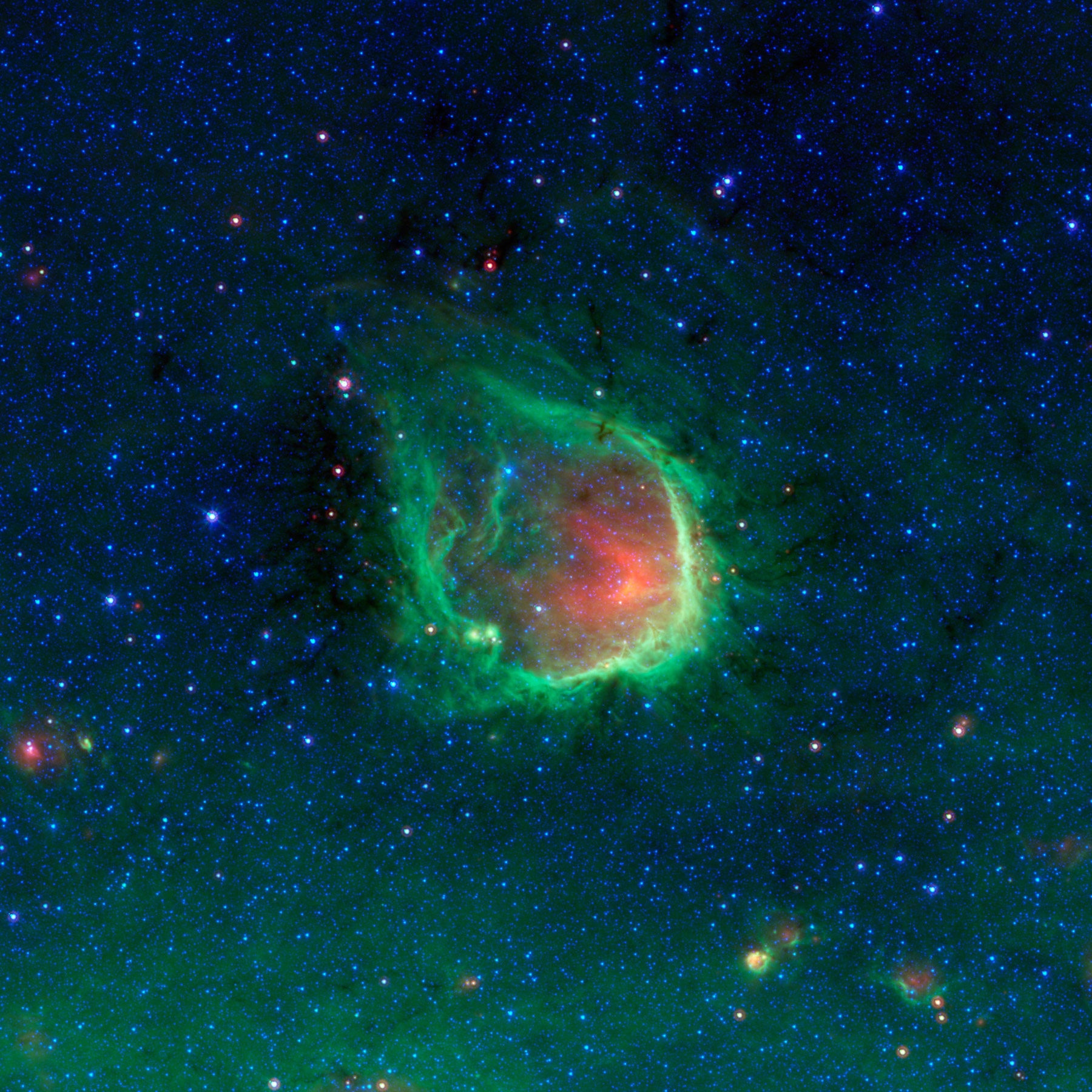Create a free profile to get unlimited access to exclusive videos, sweepstakes, and more!
A little red and green for the holiday: RCW 120, a huge shell of gas from a runaway star

Apropos of nothing*, I decided today to write about a red and green nebula. I just needed to pick one. Those shouldn't be too hard to find! Gas clouds contain hydrogen and oxygen, and those glow at the right colors. So I hit the search engines with the obvious phrase "red green nebula" and took a look at the images that came back.
… and immediately laughed out loud. Almost all the images returned came from far-infrared observatories like WISE and Spitzer Space Telescope; it had momentarily slipped my mind that the colors they use in their images are predominantly red and green. I was expecting visible light images! But that's OK, colors are colors, and so I poked around what was there to find something fun to write about.
This one came up near the top, and I have to admit I chose it for a couple of reasons besides the colors. But here, let's take a look first:
Wow! That's RCW 120, in an image taken by Spitzer in 2011. It’s a six-light-year-wide cloud of glowing gas and dust in our galaxy about 5,000 light years away. It's being lit by a massive star inside it. What's shown as green here is actually from warm long-chain carbon molecules (also called, get this, polycyclic aromatic hydrocarbons: basically soot) glowing at a wavelength of 8 microns, and red is even cooler dust at 24 microns (blue is 3.6 microns, still in the infrared, but most dust doesn't glow at that wavelength; stars put out a lot of it, which is why they look predominantly blue in the image).
The shape is curious. At first I thought it might be what we call a Strömgren sphere, a spherical shell of material around a hot star set to glow by the fierce light from the star. But the shape is weird; it’s nice and round on the right, but on the left it looks more like a high-speed photograph of a balloon popping. In dense nebulae you sometimes see a blowout, where a part of the wall of a bubble gets disrupted somehow (usually if the star is sitting inside a huge cloud near the edge, and as it heats the gas inside it inflates and blows out the side of the cloud; the Orion Nebula is an example of that).
But this doesn't look much like that; the structure is too well organized to my eye to be a blowout. Scratching my head, I looked through some literature and quickly got my answer: The massive star lighting up the nebula is a runaway O star, a very massive star (30 times the mass of the Sun!) that has a very high velocity through space. This can happen if it started out life as a companion to another star that went supernova; the sudden loss of mass in the supernova star means it can't hold on to the second star, so it goes shooting off into space like a stone flung from a sling.
That explains the shape! These stars are incredibly luminous, and also blow off a fierce wind of subatomic particles, like a solar wind but much stronger and faster. This particular star is moving through a region of the galaxy that's thick with dust, so the expanding wind from the star plows a bubble around it as it moves. Also, the material behind it will flow around that bubble, get turbulent, and form that tadpole-like tail. The intense radiation from the star lights everything up, even from a distance of a couple of dozen trillion kilometers!
The amount of material in that shell is daunting, somewhere between one and two thousand times the mass of the Sun. That's enough stuff to make a lot of stars, and the compression from the O star's wind may be enough to trigger star formation in it.
Impressive. And there’s more to come: Massive stars like this one don’t live long. It’s already roughly 5 million years old, and I don’t expect it has that much time left in its life. And when it goes, it goes with a bang: It’ll explode as a supernova. When that happens the fireworks will really begin; the flash of light from the explosion will light up material for dozens of light years around it, and then the expanding debris will slam into all that stuff and compress it madly. It’ll be quite a show … in a million years or two.
But even then, the demise of this star will probably compress so much of the gas and dust around it that dozens or even hundreds of new stars will be born from it. Heavy elements like iron, oxygen, and calcium created in the heat and pressure of the shock wave of the supernova will seed that gas as well, becoming incorporated into any planets that form there. If life ever evolves on those planets, using those elements in its biology, it’ll have that long-dead star to thank. It’s the cosmic cycle of stellar life, if you will.
Seeing as how it’s the end of the year now, and a new one is about to begin, there may be some symmetry here. I didn’t choose this object because of that symbolism — I just wanted to find a red and green nebula! — but it’s still a fun bonus to an already interesting object.
When you find yourself near a tree with red and green blinking lights on it, thank whatever eons-ago exploded star provided the elements that made that tree and its lights possible. And you too: You are the ash from a star that lived and died long before the Sun itself formed.
There’s a thought for you to end the year with. Happy holidays!
*That’s a lie, obviously.




























